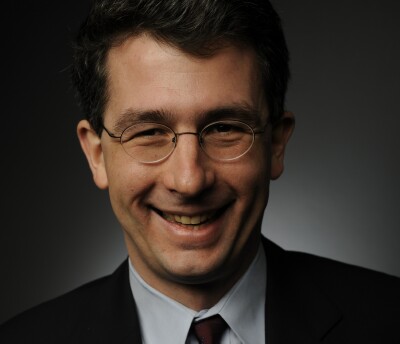Marco Bertozzi of Publicis' VivaKi -- The Jay Sears Interview

Editor’s Note -- Be sure to read these additional interviews by Jay Sears with other media professionals who recently participated in Rubicon Project’s programming during Advertising Week Europe in London: Nicolas Bidon of WPP’s Xaxis, Steve Hobbs of Aegis’ Amnet, Stephen Edwards of Hearst Magazines U.K. and Cristina Sagarduy of Omnicom Media Group’s Annalect.
Today we present a Q&A with advertising automation executive Marco Bertozzi of Publicis’ VivaKi. Marco recently participated in Rubicon Project’s programming at Advertising Week Europe in London.
Your Name: Marco Bertozzi
Your Company: VivaKi
Your Title: Executive Managing Director, EMEA
SEARS: What flavor ice cream best describes your management style?
BERTOZZI: Cookies and cream – you have to take the crunchy and the smooth.
SEARS: On average in the EMEA market -- out of each $1.00 spent on media (all media, not just digital) by one of your advertisers, how much today is spent on automated or programmatic channels?
BERTOZZI: $0.04. Definitions of programmatic vary wildly so making comparisons between organizations can be difficult.
SEARS: What will this number be in 2015?
BERTOZZI: $0.08
SEARS: Describe how most media (all media, digital + non-digital, non-programmatic media) is bought and sold today.
BERTOZZI: Planning and buying is still largely a non-automated business in the context of digital exchange trading. All channels use technology to facilitate processes -- DDS in TV as an example. The true interaction of buyer and seller through a tech platform is limited to Search, API work across Facebook, Twitter and LinkedIn, etc. and exchange trading.
Planning is still being driven by offline systems that set the picture to be interpreted online. The shift to programmatic means advertisers are creating portraits in real data that we can immediately execute across the digital ecosystem. The Data advertisers own online and CRM data, combined with publisher data and the tech to join them up will drive the next stage of data planning.
SEARS: Tell us the about the EMEA operations of VivaKi:
BERTOZZI: VivaKi is the global leader in digital advertising solutions working with Publicis Groupe agencies to help them and their clients navigate the evolving and chaotic media landscape. We focus on the three areas of Addressability, Dynamic Interaction and Data. Our EMEA operations span 17 markets and are delivered through a combination of people on the ground locally, supported by a central Activation Centre based in Amsterdam and regional leaders of our Platform and channels.
SEARS: Please tell us:
- SEARS: Percentage increase, managed budget (media spend) 2013 vs. expected 2014 for EMEA:
o BERTOZZI: 70%
- SEARS: How many employees are there in EMEA?
o BERTOZZI: We have a total of 90 people working across 17 markets in EMEA
- SEARS: What countries are you entering in 2014?
o BERTOZZI: We realized very aggressive growth plans for 2013 launching two regional Activation Centers -- firstly in Amsterdam to scale AOD across EMEA with the launch of an Activation Center in Singapore towards the end of 2013 to drive growth of AOD across Asia Pacific.
We have seen significant growth through the Activation Centers and have a number of further market launches lined up this year. In addition we are also planning to expand the number of markets across UAE through our Activation Center in Dubai.
SEARS: What are VivaKi AOD’s three biggest initiatives in EMEA for 2014?
BERTOZZI:
1. 2013 saw us implement aggressive global growth plans with rapid expansion across a number of markets and 2014 will see continued investment in developing these markets into programmatic leaders. Every market from London to Moscow is on a curve of programmatic sophistication and so we are running at different speeds across each of them. Education of agencies, publishers and shared knowledge through the AOD Platform helps everyone accelerate.
2. We are launching a major development of VivaKi Verified, our proprietary process that rigorously reviews all media, data and technology partners across client critical needs to ensure the highest level of brand safety, consumer privacy and client data protection. We will create our own Quality index across every one of our URLs and as an example will combine leading data suppliers in the area of viewability. This will continue to provide reassurance for advertisers as well as a whole new way of targeting campaigns day-to- day.
3. SkyScraper is our Groupe data warehousing proposition -- a single data store with 95% of Publicis Groupe spend data, adserving data, DSP data and third party data. This is an infrastructure we have been working on for a number of years and will become very much front and centre of operations in 2014 as we continue to grow out data sophistication.
SEARS: By 2015, what percentage of total media spend in the EMEA region across your holding company will be programmatic?
BERTOZZI: We estimated at around $0.08.
SEARS: To reach a higher adoption of direct order automation and use of the programmatic channel, what are the major impediments to overcome?
BERTOZZI: I believe that there are many companies who are pushing for direct deals / programmatic premium or whatever the latest buzz word is. I actually don’t think things have moved forward much in 12 months. The idea of private market places has moved forward very fast and is a large part of what we do in AOD, but the idea of a single IO line item being delivered to a single media owner at a set CPM is less prevalent.
There still needs to be tech development and alignment. For example there have been a couple of occasions where AOD wanted to push a large block of spend across some premium publishers and we could not get the money away as the publishers were not ready to accept it. Part tech issues, part inventory.
SEARS: How are RFPs used between your operating agency clients and your trading desk? What does a “Programmatic IO” or a “Programmatic RFP” look like?
BERTOZZI: I think we are in danger of building this unique process and infrastructure around programmatic. We need to remember this is still planning and buying and ultimately starts with an advertiser and a brief. Initially briefs are focused on our clients’ challenge and it is our job to build out a strategy that answers that. The tools and techniques we use vary, real-time data instead of offline static data etc. but the goal is the same.
As we work with advertisers we work on deeper and deeper strategies that move away from a line item to a platform for their digital advertising. The sooner we do that, the better the results.
SEARS: What should top comScore publisher CROs do to build their direct order automation and programmatic selling with your trading desk and operating agencies?
BERTOZZI: First of all every publisher needs to break down their own siloes. It is vital that they set up their internal adservers to manage the sale of inventory to the best bidder, not carve off inventory to direct sales and then pump the rest out. We as buyers in programmatic should compete with their internal teams for the best of the best.
Publishers need to align inventory and creative product development with the programmatic space from the outset. Start to shape the business around it early in the planning cycle so the company slowly evolves over time.
Publishers need to know their data intimately; they need to value it so they can have discussions with a real stance on how they think they stack up versus the market and where possible have evidence to back it up.
Employ the right talent to be able to do all of this. There are still too many companies with the wrong balance of people calling the shots. Agency trading desks, independent trading desks and others are all tooling up in this space so if publishers don’t they will be at a disadvantage.
SEARS: Why is direct order automation so important? Is it important?
BERTOZZI: Being able to combine a Publisher’s first party data, with advertiser data across premium inventory is going to be very important for this business to evolve. Managing where and how spend is delivered has always been important to advertisers but I believe there is still a lot of hype in this space and mainly generated by those with the most to gain.
SEARS: What countries in the EMEA region are the leaders and laggards in programmatic?
BERTOZZI: There are no laggards; there are countries that live with different pressures to others and those that have a particular client base. We have seen the UK and France expand rapidly. This time last year we were all bemoaning Germany but we have seen considerable expansion there as well now.
We are expanding with new markets, all hungry to be part of the revolution which is very exciting, but in every market we have to take our time and move as fast as market conditions allow, all the time educating and demonstrating benefits.
Tell us a bit more about you:
SEARS: If you could choose a movie star to be the global head of your trading desk, who would you choose and why?
BERTOZZI: That’s easy. It would need to be a superhero. Let’s keep it simple and call it Superman. They have to fly around a lot, be able to resist the slings and arrows of the industry but never tire and want to change the world for the better! The X-ray vision would come in useful to see through the bullshit.
SEARS: If you could travel for pleasure anywhere in the world, to a place you have never been, where would you go?
BERTOZZI: There are too many places, but somewhere remote, with sea and mountains, and ideally somewhere without a connection so I can for once switch off from the emails!
SEARS: If you were trapped alone on a desert island and needed to choose one ad holding company CEO to accompany you ( other than your own holding company CEO), which CEO would you pick and why?
BERTOZZI: That would have to be John Wren, for rather obvious reasons!
SEARS: What is your favorite restaurant in the world?
BERTOZZI: It has to be the crazy, authentic restaurant in my home town of Cesena that I have been eating at all my life.
Thanks Marco!
Jay Sears is Senior Vice President, Marketplace Development for the Rubicon Project. Sears works with leadership and business unit heads across the company to expand Rubicon Project’s potential market. Sears has also served as General Manager, REVV Buyer, where he was responsible for global relations with the buy side including ad holding companies, ad agencies, agency trading desks and demand side platforms headquartered in North America. Jay can be reached at jsears@rubiconproject.com.
with leadership and business unit heads across the company to expand Rubicon Project’s potential market. Sears has also served as General Manager, REVV Buyer, where he was responsible for global relations with the buy side including ad holding companies, ad agencies, agency trading desks and demand side platforms headquartered in North America. Jay can be reached at jsears@rubiconproject.com.
Check us out on Facebook at MediaBizBloggers.com
Follow our Twitter updates at @MediaBizBlogger
The opinions and points of view expressed in this commentary are exclusively the views of the author and do not necessarily represent the views of MediaBizBloggers.com management or associated bloggers. MediaBizBloggers is an open thought leadership platform and readers may share their comments and opinions in response to all commentaries.


